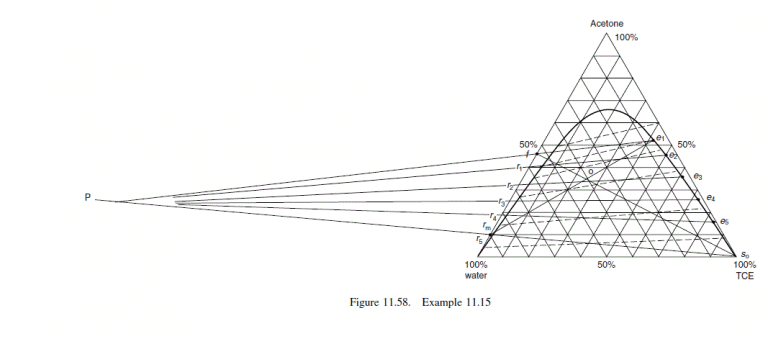Composition of feed + solvent, point o = 0.45 x 100/(100 + 32) = 0.34 = 34 per cent.
Draw line from TCE (trichloroethane) = 100 per cent, point s0, to feed composition, f, 45 per cent acetone.
Mark point o on this line at 34 per cent acetone.
Mark required final raffinate composition, r_{m}, on the equilibrium curve, at 10 per cent.
Draw line from this point through point o to find final extract composition, e_{1}.
Draw line from this point though the feed composition, f, extend this line to cut a line extended from s_{0} \text { through } r_{m}, at P.
Using the tie-lines plotted on the figure, judge the position that a tie-line would have from e_{1} and mark it in, to find the point on the curve giving the composition of the raffinate leaving the first stage, r_{1}.
Draw a line through from the pole point P through r_{1}, to find the point on the curve giving the extract composition leaving the second stage, e_{2}.
Repeat these steps until the raffinate composition found is below 10 per cent.
From the diagram, Figure 11.58, it can be seen that five stages are needed.
That the raffinate composition from stage 5 passes through the specified raffinate composition of 10 per cent is fortuitous. As the construction, particularly the judgement of the position of the tie-lines, is approximate, the number of stages will be increased to six. This should ensure that the specified raffinate composition of below 10 per cent is met.
Immiscible solvents
If the solvents are immiscible the procedure for determining the number of stages required is simplified. The equilibrium curve can be drawn on regular, orthogonal, graph paper. An operating line, giving the relationship between the compositions of the raffinate and extracts entering and leaving each stage, can then be drawn, and the stages stepped off. The procedure is similar to the McCabe Thiele construction for determining the number of stages in distillation; Section 11.5.2. The slope of the operating line is the ratio of the final raffinate to fresh solvent flow-rates.
For a full discussion of the methods that can be used to determine the stage requirements in liquid liquid extraction refer to Treybal (1980), Perry et al. (1997) and Robbins (1997).
Computer programs are available for the design of extraction processes and would normally be included in the various commercial process simulation packages available; see Chapter 4.
